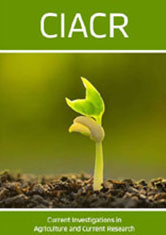
Lupine Publishers Group
Lupine Publishers
Menu
ISSN: 2637-4676
Research Article(ISSN: 2637-4676) 
Production and Nutritional Composition of two Annual Ryegrass Cultivars (Diploid and Tetraploid) Volume 7 - Issue 2
António Moitinho Rodrigues1,2*, Abel Veloso1, Edgar Vaz1 and José Fragoso de Almeida1
- 1 School of Agriculture of the Polytechnic, Institute of Castelo Branco, Portugal
- 2 CERNAS / IPCB - Center for Natural Resources, Environment and Society, Polytechnic Institute of Castelo Branco, Portugal
Received: July 17, 2019; Published: July 25, 2019
Corresponding author: António Moitinho Rodrigues, School of Agriculture of the Polytechnic Institute of Castelo Branco, Portugal
DOI: 10.32474/CIACR.2019.07.000258
Abstract
The feed cost represents the major cost in milk production. Direct grazing and forage produced on the dairy farm could allow the farmer to a better feed production cost control. Ryegrass have been extensively used for grazing and forage production. This study evaluates the production and nutritional composition of two ryegrass cultivars diploid and tetraploid alone or in a binary mixture (50:50). The results showed that the binary mixture is a good option because of its higher production of DM/ha, higher ME and NFC and lower content of NDF, ADF and ADL.
Keywords: Diploid Ryegrass; Tetraploid Ryegrass; Nutritive Value; Mediterranean Region
Introduction
The feeding cost represent 50 to 78.4% of the total milk production costs Alqaisi et al. [1] Baptista et al. [2] Sottomayor et al. [3] and have an important impact in milk production price. The milk price paid to Portuguese dairy farmers is one of the five lowest in the European Union (EU). In May 2019, the Portugal milk price was 0.3025 €/kg. The EU average in the same month was 0.3383 €/kg MMO [4]. These facts show that to increase farm profitability it is essential satisfy the nutritional requirements of the dairy cows and also reduce the feeding costs. One way to achieve this is to work with a feeding plan based on forage produced on the farm which are often economically more interesting than others feeding plans based on commercial compound whose price dairy farmer don’t control Alqaisi et al. [1]. Ryegrass (Lolium multiflorum Lam.) have been one of the most common forage used to feed dairy cows Wilson and McDowall [5], Tas [6] Cooke et al. [7,8], It can be fed by direct grazing, in the form of hay, silage, haylage or mixed grazing and conservation systems. Additionally, the use of annual ryegrass to feed dairy cows have a positive effect on milk unsaturated fatty acids, particularly in the linoleic and α-linolenic acids Kalač and Samková [9]. The aim of this study is to evaluate the production and nutritional composition of two ryegrass varieties diploid (n2) and tetraploid (n4), cultivated in a Thermo-Mediterranean climate as single culture or binary mixture.
Materials and Methods
The experiment took place on Polytechnic Institute of Castelo Branco farm (39°49’35’’N; 07°27’26’’O). Two different varieties of ryegrass were used. The main goal was to evaluate the forage production and nutritional composition of three annual ryegrass forages: single culture diploid cultivar, single culture tetraploid cultivar and binary mixture (diploid: tetraploid 50:50). Before sowing, a basal application of 30 kg N/ha was made. Soil analyzes revealed no need to apply any other nutrients at sowing. At day 83 after sowing was applied to the soil in top dressing 30 kg N/ha. Between 80 and 82 days after sowing, the trial plots were grazed by sheep. In order to estimate forage yield 182 days after sowing ryegrass samples were collected in each plots (5 sampling points per plot, 0.1 m2/sampling point). Each ryegrass sample were chemical analyzed for total dry matter (DM), total ash (Ash), crude protein (CP) (N x 6,25) and ether extract (EE) according AOAC (2000) and neutral detergent fiber (NDF), acid detergent fiber (ADF) and acid detergent lignin (ADL) according to the procedures described by Van Soest et al. [10] Non fiber carbohydrates (NFC) was calculated according NRC [11] [NFC (%DM) = 100 – (CP + EE + Ash + NDF)]. Metabolizable energy (ME) for ruminants was calculated by prediction equations proposed by NRC (2001) [ME (MJ/kgDM) = (TDN% x 3.6)/100 x 4.184] and total digestible nutrients (TDN) was calculated by prediction equation described by Bath and Marble cited by Coppock [12] [TDN (%) = 82.38 – (0.7515 x ADF %)]. With respect to the original equation, this ME equation includes DM x 4.184 that account for conversion ME data from Mcal to MJ. Data were subjected to analysis of variance (ANOVA) using the General Linear Model procedure in IBM SPSS and Bonferroni test was used as a Post Hoc Test to detect significant differences (p≤0.05) among treatment means.
Results and Discussion
One hundred and eighty three days after sowing n2 ryegrass cultivar showed a lower height, more delicate stems, narrower leafs and smaller nodes. On the contrary, the n4 ryegrass cultivar showed a more impressive vegetative growth, with higher stems and longer and broader leafs. The higher productions were obtained for the tetraploid cultivar (45.06 t fresh matter/ha or 10.26 t DM/ha) and for the binary mixture (44.72 t fresh/ha or 10.54 t DM/ha). The diploid cultivar showed the lowest production values (25.84 t fresh/ha or 8.20 t DM/ha). The fresh production of the tetraploid cultivar was 1.74 times higher than the diploid cultivar but only 1.25 times higher when the dry matter production is considered. Lopes et al. [13] refer productions of 30 to 40 t fresh/ha with 16 to 18% of DM corresponding to a production of 5 to 7 t DM/ha. The results obtained in our study are higher than the results reported by Lopes et al. [13]. but within the range of the figures obtained by Lemus [12] which analyzed the productions of seven cultivars of diploid ryegrass (8.2 to 17.1 t DM/ha) and eleven cultivars of tetraploid ryegrass (8.6 to 18.9 t/ha). Table 1 presents the 3 treatments ryegrass chemical composition. There were significant differences between treatments (p≤0.05) in the mean values of DM, EE, ash and NFC. The diploid cultivar showed the highest content of DM (30.64%) and EE (2.87%DM). Tetraploid cultivar showed the highest content of ash (9.54%DM) and the binary mixture showed the highest content of NFC (26.14%DM). There weren’t found any statistically significant differences for the other variables. However diploid ryegrass had higher content of CP (9.62%DM), NDF (57.05%DM), ADF (35.54%DM) and ADL (5.74%DM) (p>0.05). The binary mixture had the highest content of ME (11.02 MJ/kg DM) (Table 1). The binary mixture of diplod: tetraploid ryegrass (50:50) appears to be an interesting solution to feed dairy cows because it has higher DM productions per ha and higher content of ME and NFC.
Table 1: Diploid ryegrass cultivar (n=5), tetraploid ryegrass cultivar (n=5) and diploid: tetraploid 50:50 (n=5) ryegrass chemical composition and comparison with NRC (2001) figures for ryegrass hay and ryegrass silage.

MS – dry matter, ME - metabolizable energy, CP - crude protein, EE – ether extract, ash, NDF – neutral-detergente fiber, ADF – aciddetergent fiber, ADL – acid-detergent lignin, NFC – non fiber carbohydrates.
The values found for ME, EE, ash, NDF, ADF and ADL are similar to the figures reported by NRC (2001) for hay and ryegrass silage (Table 1). On the other hand, the CP content found in our study is lower and the NFC content is higher than the figures reported by NRC [11]. As ryegrass is a member of Poaceae family, the low CP content should not be considered as a problem, because it can be overcome by the usage of legume forage, plain or in consociation. Additionally, the forage CP content might had been higher if the nitrogen fertilization during sowing was higher or if the ryegrass harvest had been done earlier. In both cases, changes in the cell wall carbohydrates were not expected Peyraud and Astigarraga [14]. The CP from ryegrass is quickly and extensively digested by the rumen microbes which can cause an excessive amount of ammonia in the rumen. More than 80% is absorbed through the rumen wall, converted to urea in the liver and released in the urine, milk and saliva. As a result, the nitrogen use efficiency of dairy cows fed with ryegrass is relatively low, frequently below 0.25 g of nitrogen in milk per g of nitrogen ingested Kolver [13], Tas [6]. In many European regions, this low efficiency is considered as a major source of soil and water pollution. Nevertheless, the nitrogen use efficiency of dairy cows fed with ryegrass can be improved by reducing the nitrogen fertilization Peyraud and Astigarraga [14], Valk et al. [15-19], by the partial substitution of ryegrass favoring forages with lower CP content or by increasing the consumption of feed richer in easily fermentable carbohydrates Bargo et al. [13].
Conclusion
Binary diplod: tetraploid ryegrass mixture (50:50) has been an interesting solution because it produced more DM per ha, with higher contents of ME, NFC (p≤0.05) and less NDF, ADF and ADL. The diploid cultivar had higher contents of DM (p≤0.05), CP and EE (p≤0.05). Nevertheless, the diploid cultivar appears to be the worst solution, not only for its lower DM production per ha, but also for its higher content of NDF, ADF and ADL.
References
- Alqaisi O, Steglich J, Ndambi A, Hemme T (2011) Feeding systems: an assessment of dairy competitiveness. In: IFCN Dairy Report, pp. 174-175.
- Lineth J Vega-Rojas, Margarita Contreras Padilla, Natalia Rincon Londoño, Alicia del Real López, Rosa M Lima Garcia, et al. (2016) The Effect of Maize Grain Size on the Physicochemical Properties of Isolated Starch, Crude Maize Flour and Nixtamalized Maize Flours. Agricultural Sciences 7(2).
- Baptista F, Murcho D, Silva LL, Marques C (2012) Energy efficiency measures in Portuguese Dairy Cows production. In: Economic and environmental analysis of energy efficiency measures in agriculture. Case Studies and trade offs, Meyer-Aurich et al. (Eds.), p. 58-62.
- Bargo F, Muller LD, Kolver, ES, Delahoy (2003). Production and digestion of supplemented dairy cows on pasture. Journal of Dairy Science 86(1): 1-42.
- Cooke KM, Bernard JK , West JW (2008) Performance of Dairy Cows Fed Annual Ryegrass Silage and Corn Silage with Steam-Flaked or Ground Corn. Journal of Dairy Science 91(6): 2417-2422.
- Cooke KM, Bernard JK, West JW (2009) Performance of lactating dairy cows fed ryegrass silage and corn silage with ground corn, steam-flaked corn, or hominy feed. Journal of Dairy Science 92(3): 1117-1123.
- Coppock CE (1997) Adjusting rations to forage quality, and suggested criteria to use in buying forages. In: Western Dairy Management Conference, Nevada, pp. 137-143.
- Kalač P, Samková E (2010) The effects of feeding various forages on fatty acid composition of bovine milk fat: A review. Czech Journal of Animal Science 55(12): 521-537.
- Kolver ES (2003) Nutritional limitations to increased production on pasture-based systems. Proceedings of the Nutrition Society 62(2): 291-300.
- Lemus R (2017) Annual ryegrass performance in Mississippi: long-term yield production. Extension Service of Mississippi State University.
- Lopes V, Nogueira A, Fernandes A (2006) Cultura de azevém anual. Ficha Técnica 53 (edição on-line), Divisão de Documentação, Informação e Relações Públicas, D.R.A.E.D.M.
- MMO (2019) European milk market observatory - EU historical prices.
- NRC (2001) Nutrient requirements of dairy cattle. Seventh Revised Edition. National Research Council Washington USA.
- Peyraud J, Astigarraga L (1998) Review of the effect of nitrogen fertilization on the chemical composition, intake, digestion and nutritive value of fresh herbage: consequences on animal nutrition and N balance. Animal Feed Science and Technology 72(3-4): 235-259.
- Sottomayor M, Costa L, Ferreira MP (2012) Impacto da Reforma da PAC Pós - 2013 no Setor do Leite em Portugal - Report 6.07.2012. Study conducted for FENALAC by CEGEA from Universidade Católica Portuguesa.
- Tas B (2006) Nitrogen utilization of perennial ryegrass in dairy cows. In A Elgersma, J Dijkstra e S Tamminga (eds.), Fresh Herbage for Dairy Cattle, pp. 125-140.
- Valk H, Leusink Kappers IE, Van Vuuren AM (2000) Effect of reducing nitrogen fertilizer on grassland on grass intake, digestibility and milk production of dairy cows. Livestock Production Science 63(1): 27-38.
- Van Soest PJ, Robertson JB, Lewis BA (1991) Methods for dietary fiber, neutral detergent fiber, and nonstarch polysaccharides in relation to animal nutrition. Journal of Dairy Science 74(10): 3583-3597
- Wilson GF, McDowall FH (1966) Ryegrass varieties in relation to dairy cattle performance. New Zealand Journal of Agricultural Research 9(4): 1042-1052.

Top Editors
-

Mark E Smith
Bio chemistry
University of Texas Medical Branch, USA -

Lawrence A Presley
Department of Criminal Justice
Liberty University, USA -

Thomas W Miller
Department of Psychiatry
University of Kentucky, USA -

Gjumrakch Aliev
Department of Medicine
Gally International Biomedical Research & Consulting LLC, USA -

Christopher Bryant
Department of Urbanisation and Agricultural
Montreal university, USA -

Robert William Frare
Oral & Maxillofacial Pathology
New York University, USA -

Rudolph Modesto Navari
Gastroenterology and Hepatology
University of Alabama, UK -

Andrew Hague
Department of Medicine
Universities of Bradford, UK -

George Gregory Buttigieg
Maltese College of Obstetrics and Gynaecology, Europe -

Chen-Hsiung Yeh
Oncology
Circulogene Theranostics, England -
.png)
Emilio Bucio-Carrillo
Radiation Chemistry
National University of Mexico, USA -
.jpg)
Casey J Grenier
Analytical Chemistry
Wentworth Institute of Technology, USA -
Hany Atalah
Minimally Invasive Surgery
Mercer University school of Medicine, USA -

Abu-Hussein Muhamad
Pediatric Dentistry
University of Athens , Greece

The annual scholar awards from Lupine Publishers honor a selected number Read More...




